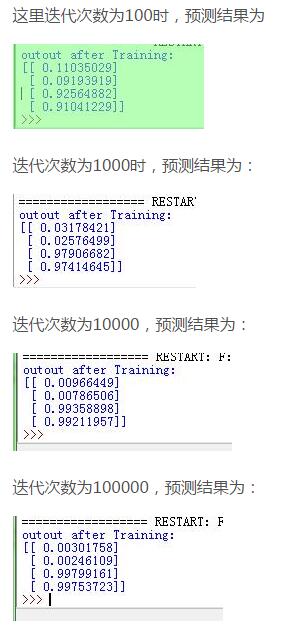python实现简单神经网络算法,供大家参考,具体内容如下
python实现二层神经网络
包括输入层和输出层
import numpy as np
#sigmoid function
def nonlin(x, deriv = False):
if(deriv == True):
return x*(1-x)
return 1/(1+np.exp(-x))
#input dataset
x = np.array([[0,0,1],
[0,1,1],
[1,0,1],
[1,1,1]])
#output dataset
y = np.array([[0,0,1,1]]).T
np.random.seed(1)
#init weight value
syn0 = 2*np.random.random((3,1))-1
for iter in xrange(100000):
l0 = x #the first layer,and the input layer
l1 = nonlin(np.dot(l0,syn0)) #the second layer,and the output layer
l1_error = y-l1
l1_delta = l1_error*nonlin(l1,True)
syn0 += np.dot(l0.T, l1_delta)
print "outout after Training:"
print l1
import numpy as np
#sigmoid function
def nonlin(x, deriv = False):
if(deriv == True):
return x*(1-x)
return 1/(1+np.exp(-x))
#input dataset
x = np.array([[0,0,1],
[0,1,1],
[1,0,1],
[1,1,1]])
#output dataset
y = np.array([[0,0,1,1]]).T
np.random.seed(1)
#init weight value
syn0 = 2*np.random.random((3,1))-1
for iter in xrange(100000):
l0 = x #the first layer,and the input layer
l1 = nonlin(np.dot(l0,syn0)) #the second layer,and the output layer
l1_error = y-l1
l1_delta = l1_error*nonlin(l1,True)
syn0 += np.dot(l0.T, l1_delta)
print "outout after Training:"
print l1 这里,
l0:输入层
l1:输出层
syn0:初始权值
l1_error:误差
l1_delta:误差校正系数
func nonlin:sigmoid函数

可见迭代次数越多,预测结果越接近理想值,当时耗时也越长。
python实现三层神经网络
包括输入层、隐含层和输出层
import numpy as np
def nonlin(x, deriv = False):
if(deriv == True):
return x*(1-x)
else:
return 1/(1+np.exp(-x))
#input dataset
X = np.array([[0,0,1],
[0,1,1],
[1,0,1],
[1,1,1]])
#output dataset
y = np.array([[0,1,1,0]]).T
syn0 = 2*np.random.random((3,4)) - 1 #the first-hidden layer weight value
syn1 = 2*np.random.random((4,1)) - 1 #the hidden-output layer weight value
for j in range(60000):
l0 = X #the first layer,and the input layer
l1 = nonlin(np.dot(l0,syn0)) #the second layer,and the hidden layer
l2 = nonlin(np.dot(l1,syn1)) #the third layer,and the output layer
l2_error = y-l2 #the hidden-output layer error
if(j%10000) == 0:
print "Error:"+str(np.mean(l2_error))
l2_delta = l2_error*nonlin(l2,deriv = True)
l1_error = l2_delta.dot(syn1.T) #the first-hidden layer error
l1_delta = l1_error*nonlin(l1,deriv = True)
syn1 += l1.T.dot(l2_delta)
syn0 += l0.T.dot(l1_delta)
print "outout after Training:"
print l2 import numpy as np
def nonlin(x, deriv = False):
if(deriv == True):
return x*(1-x)
else:
return 1/(1+np.exp(-x))
#input dataset
X = np.array([[0,0,1],
[0,1,1],
[1,0,1],
[1,1,1]])
#output dataset
y = np.array([[0,1,1,0]]).T
syn0 = 2*np.random.random((3,4)) - 1 #the first-hidden layer weight value
syn1 = 2*np.random.random((4,1)) - 1 #the hidden-output layer weight value
for j in range(60000):
l0 = X #the first layer,and the input layer
l1 = nonlin(np.dot(l0,syn0)) #the second layer,and the hidden layer
l2 = nonlin(np.dot(l1,syn1)) #the third layer,and the output layer
l2_error = y-l2 #the hidden-output layer error
if(j%10000) == 0:
print "Error:"+str(np.mean(l2_error))
l2_delta = l2_error*nonlin(l2,deriv = True)
l1_error = l2_delta.dot(syn1.T) #the first-hidden layer error
l1_delta = l1_error*nonlin(l1,deriv = True)
syn1 += l1.T.dot(l2_delta)
syn0 += l0.T.dot(l1_delta)
print "outout after Training:"
print l2 以上就是本文的全部内容,希望对大家的学习有所帮助,也希望大家多多支持亿速云。
亿速云「云服务器」,即开即用、新一代英特尔至强铂金CPU、三副本存储NVMe SSD云盘,价格低至29元/月。点击查看>>
免责声明:本站发布的内容(图片、视频和文字)以原创、转载和分享为主,文章观点不代表本网站立场,如果涉及侵权请联系站长邮箱:is@yisu.com进行举报,并提供相关证据,一经查实,将立刻删除涉嫌侵权内容。